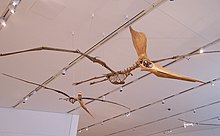Caelidracones
| Caelidracones Temporal range: Middle Jurassic–Late Cretaceous,
| |
|---|---|

| |
| Replica Geosternbergia sternbergi skeletons, female (left) and male (right) | |
| Scientific classification | |
| Domain: | Eukaryota |
| Kingdom: | Animalia |
| Phylum: | Chordata |
| Order: | †Pterosauria |
| Clade: | †Pterodactyliformes |
| Clade: | †Caelidracones Unwin, 2003 |
| Subgroups[1] | |
The Caelidracones are a group of pterosaurs.[2]
The clade Caelidracones was defined in 2003 by David Unwin as the group consisting of the last common ancestor of Anurognathus ammoni and Quetzalcoatlus northropi, and all its descendants.[3]
The name Caelidracones means "sky dragons" from Latin caelum, "heaven", and draco, "dragon" and is a reference to Harry Govier Seeley's 1901 book, Dragons of the Air.
In Unwin's original classification, the Caelidracones were considered the sister group of the Dimorphodontidae within the Macronychoptera and consist of the Anurognathidae and the Lonchognatha.[3] More recent studies of pterosaur relationships have found anurognathids and pterodactyloids to be sister groups, which would limit Caelidracones to just those two clades.[1]
References
- ^ a b Andres, B.; Myers, T. S. (2013). "Lone Star Pterosaurs". Earth and Environmental Science Transactions of the Royal Society of Edinburgh. 103 (3–4): 383–398. doi:10.1017/S1755691013000303.
- ^ "†unranked clade Caelidracones Unwin 2003 (pterosaur)". Paleobiology Database. Fossilworks. Retrieved 27 April 2016.
- ^ a b Unwin, D. M. (2003). "On the phylogeny and evolutionary history of pterosaurs". Geological Society, London, Special Publications. 217 (1): 139–190. doi:10.1144/GSL.SP.2003.217.01.11.
